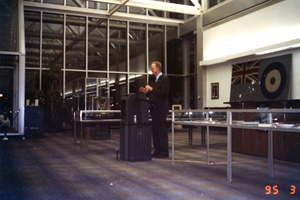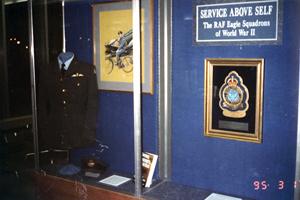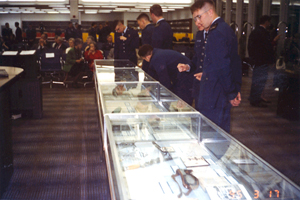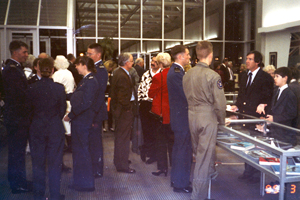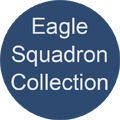The Eagles Story
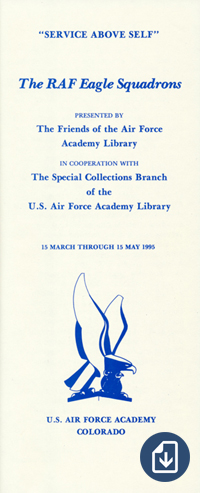 The defeat of France by Nazi Germany in June, 1940, brought the chilling realization to the world that England stood alone as the bulwark of democracy in Europe. And since her army had been decisively defeated and forced to evacuate France at Dunkirk, it was only the royal Air Force that could thwart Hitler’s planned invasion of Britain. This situation was graphically reinforced by the Battle of Britain that raged in the skies during the last half of 1940. The RAF realized early in the war that outside help was needed if there were to be enough pilots to fly the Hurricanes and Spitfires, as well as the bombers, so critical to England’s defense. Pilots were recruited from all over the world, including the United states. Although such recruiting was illegal in the U.S., even before the fall of France, and American expatriate, Colonel Charles Sweeny, was actively recruiting for American pilots. The crisis in England by mid-1940 caused the British to redouble their efforts to get more American in the RAF. This led to the formation of a group to actively recruit American pilots throughout the country, led by a World War I veteran pilot and American artist, Clayton Knight. This Clayton Knight Committee recruited hundreds of American pilots, sent them to a refresher flying school and, as the U.S. Government winked at the law, put them on ships out of Canada bound for England and service in the RAF. In addition, a large number of Americans simply went to Canada and joined the RCAF.
The defeat of France by Nazi Germany in June, 1940, brought the chilling realization to the world that England stood alone as the bulwark of democracy in Europe. And since her army had been decisively defeated and forced to evacuate France at Dunkirk, it was only the royal Air Force that could thwart Hitler’s planned invasion of Britain. This situation was graphically reinforced by the Battle of Britain that raged in the skies during the last half of 1940. The RAF realized early in the war that outside help was needed if there were to be enough pilots to fly the Hurricanes and Spitfires, as well as the bombers, so critical to England’s defense. Pilots were recruited from all over the world, including the United states. Although such recruiting was illegal in the U.S., even before the fall of France, and American expatriate, Colonel Charles Sweeny, was actively recruiting for American pilots. The crisis in England by mid-1940 caused the British to redouble their efforts to get more American in the RAF. This led to the formation of a group to actively recruit American pilots throughout the country, led by a World War I veteran pilot and American artist, Clayton Knight. This Clayton Knight Committee recruited hundreds of American pilots, sent them to a refresher flying school and, as the U.S. Government winked at the law, put them on ships out of Canada bound for England and service in the RAF. In addition, a large number of Americans simply went to Canada and joined the RCAF.
In late 1940, at the request of Charles Sweeny, Colonel Sweeny’s nephew, the British Air Ministry had agreed to form one squadron made up of American pilots under British command, Number 71 Squadron of Fighter Command. Two others, Numbers 121 and 133 Squadrons were added in 1941. Together, they were known as the “Eagle Squadrons,” and upon arrival in England, many of the Americans were sent to these three units. The Squadrons built a strong reputation for excellence and 244 American and their 16 British commanders served as Eagles. On September 29, 1942, the three Eagle Squadrons transferred to the U.S. Army Air Forces forming the Fourth Fighter Group of the Eighth Air Force stationed at Debden. Most, but not all, of the Eagles transferred to the Fourth. During their time in the RAF, the Eagles destroyed over 73 German aircraft and the Fourth Fighter Group subsequently became the highest scoring unit in the Army Air Forces with 1052 enemy aircraft destroyed.
But it is not the number of aircraft destroyed that makes the Eagles such a legend. It was their willingness to put service above self and volunteer for the cause of freedom even though they did not have to go to war. And nearly half of the 244 paid the supreme price for their willingness to serve–108 were killed in action and many more died in training or crossing the Atlantic. Another 34 became prisoners of war. Yet they had a duty to perform and when they agreed to serve in the RAF they resolved to be true to that duty and live “Service Above Self.”
The Exhibit
At their annual reunion in 1989, the members of the Eagle Squadron Association, at the request of theFriends of the Air Force Academy, designated the Special Collections Branch of the Academy Libraryas the official repository for their records. Those items to be put into the Academy Library focused on official records, personal papers and diaries, logbooks, letters, and photographs. Since that time, hundreds of items from nearly a score of Eagles have built the nucleus of a strong collection; one that has become a favorite of cadets for research.
In late 1994, the Friends of the Air Force Academy Library and the staff of the Special Collections Branch, determined that the Eagle Collection was complete enough to build a major exhibit about the Eagles. This exhibit is taken from those items that have been given to the Academy, augmented by a number that have been identified by several Eagles for future donation. The displays do not include pieces from all of the individuals represented in the Eagle Collection, but rather items were selected to illustrate the broad scope of the collection as well as tell the story of the Eagles. The Eagle Collection is far from complete and the Academy is interested in obtaining additional archival material for the collection. Every semester cadets and other researches are disappointed that there is not more in the Eagle Collection. Nonetheless, it is a good beginning, as this exhibit demonstrates, and we hope that Eagles not currently represented in the collection will donate their records before they are lost to future generations.

